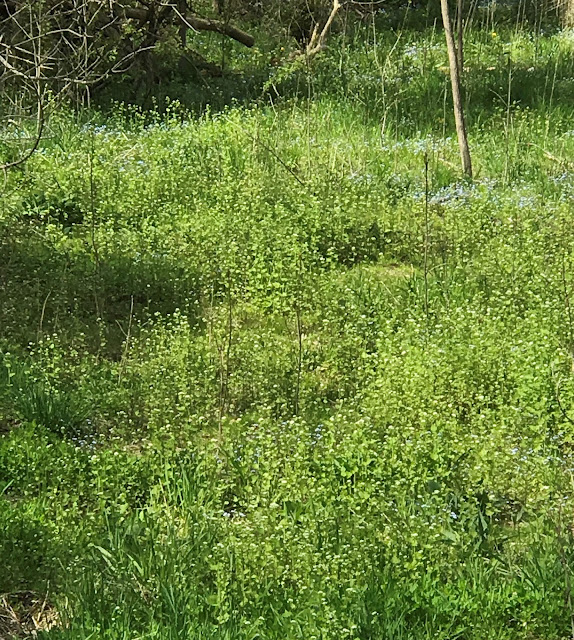Wild Chervil has infested hayfields and fencerows around crop fields thanks to its millions of seeds that distribute easily. This is a bit of the large patch around the block. As you can see it squeezes out any other plants.
Wild Chervil is a fast growing biennial that forms dense mats of fern-like leaves in the first year and flowers in the second year. It is hard to control because of its deep tap root and herbicide resistance.
The flower is similar to Queen Anne's Lace, but the small groups of florets are separated out rather than continuous. If you remember that it's fairly easy to identify.
And if you find a yellow version run the other way quick! This is Wild Parsnip and the sap of this plant can burn your skin. That's described as 'phytophotodermititis' if you want a big fancy name for it - phyto for plant, photo for exposure to the sun, and dermititis for your skin, and it can produce a nasty itchy rash.
Garlic Mustard is a nondescript weed with small white flowers that also generates millions of seeds. The main problem with this species is that it grows in the shade of deciduous forests where many of our most beloved spring wildflowers are found.
The leaves are easy to identify, heart-shaped with prominent teeth around the edge. It's a biennial too, that generates millions of seeds that can live for 30 years in the soil. Our local Bruce Trail Club has been running workshops to pull the flowers before they set seeds and has had some success controlling it.
It has spread in a large patch along both sides of the stream in this little valley, squeezing out any other plants. Who knows what it's going to look like next year!
P.S. I controlled myself to only eating only two of those strawberries I showed yesterday - and didn't pick out the biggest two either. But we had a delicious bowl of them last night!








I have probably seen these invasive plants in my daily country wanderings but never realized what they were or how much of a problem they are.
ReplyDeleteSuch self control, and they did look so delicious. Weeds, they might look pretty but guess when they spread, not good for any other plants that need their own space, and far better to be deleted!!
ReplyDeleteIt was a good read to learn some of the wild ones names. We have the Queen's Anne Lace but they mow all the ditches around here so they don't get to bloom.
ReplyDeleteI appreciate the info on these plants FG. Take care.
ReplyDeleteGarlic mustard has another insidious impact on oak forests in that it inhibits the mycorrhizal fungi which the trees depend on to acquire nutrients and water, slowing the growth of the trees and reducing their vigor. I'm not sure if it has a similar impact in northern hardwood or coniferous forests, but it may well do so.
ReplyDeleteIs the Wild Chervil also known as Cow Parsley?
ReplyDeleteI've been eating our strawberries, then my granddaughter helped!
ReplyDeleteThere are so many invasive species. What were people thinking?
I'm going to keep my eye open for Garlic mustard. And I now know which plant is Queen Anne's Lace! Thanks.
ReplyDeleteGarlic Mustard seems just about impossible to eradicate. Keeping it under control is sometimes possible, but eradication seems a bit of a pipe dream. Phragmites is even worse when it gets established.
ReplyDeleteThanks for the information about those noxious weeds. They don't seem to be growing around here, but we have others to watch out for.
ReplyDeleteI've seen both before as well.
ReplyDelete